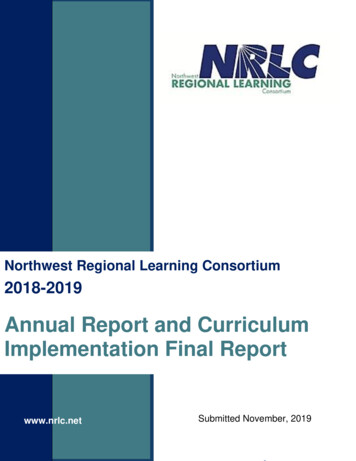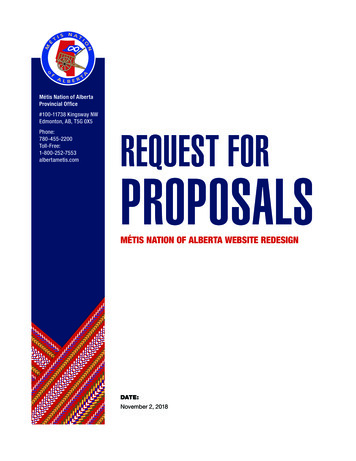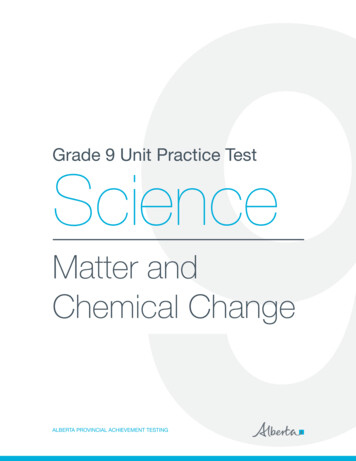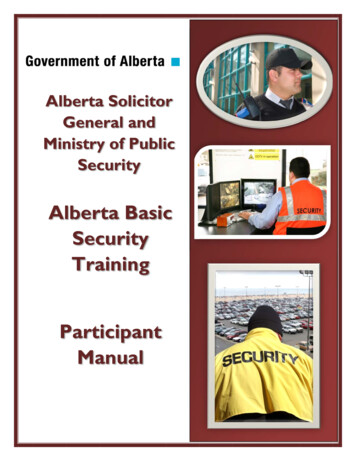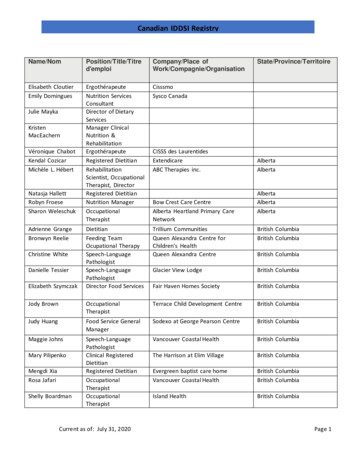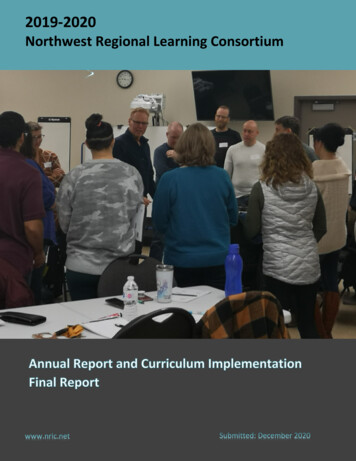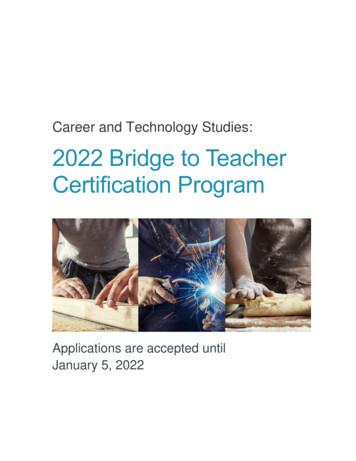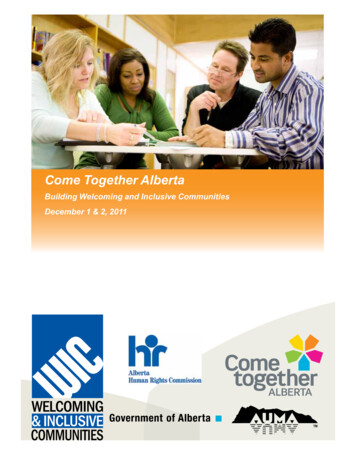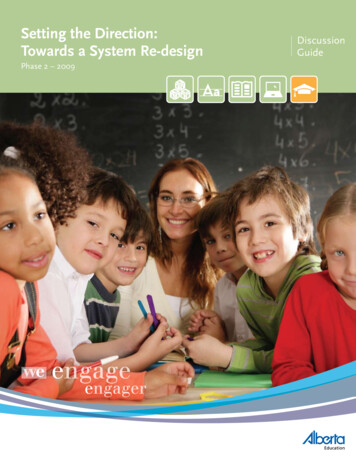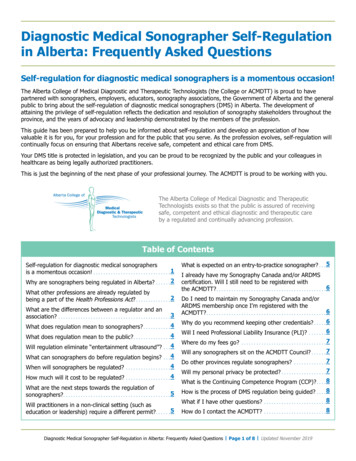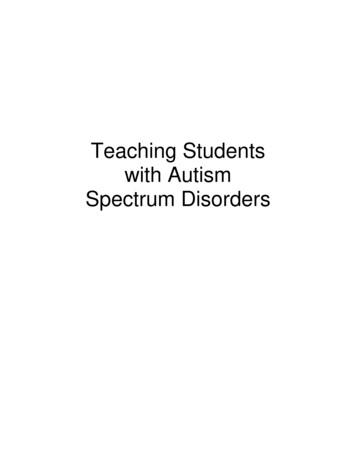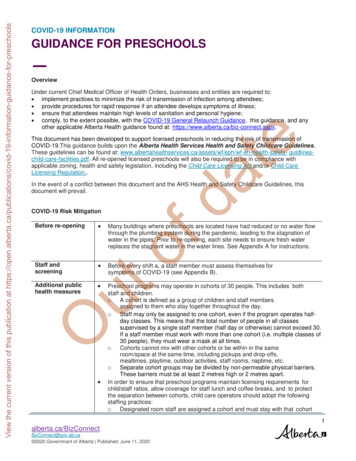
Transcription
GUIDANCE FOR PRESCHOOLSOverviewofdateUnder current Chief Medical Officer of Health Orders, businesses and entities are required to: implement practices to minimize the risk of transmission of infection among attendees; provide procedures for rapid response if an attendee develops symptoms of illness; ensure that attendees maintain high levels of sanitation and personal hygiene; comply, to the extent possible, with the COVID-19 General Relaunch Guidance, this guidance, and anyother applicable Alberta Health guidance found at: https://www.alberta.ca/biz-connect.aspx.This document has been developed to support licensed preschools in reducing the risk of transmission ofCOVID-19.This guidance builds upon the Alberta Health Services Health and Safety Childcare Guidelines,These guidelines can be found at: ealth-safety- guidlineschild-care-facilities.pdf. All re-opened licensed preschools will also be required to be in compliance withapplicable zoning, health and safety legislation, including the Child Care Licensing Act and/or Child CareLicensing Regulation,.In the event of a conflict between this document and the AHS Health and Safety Childcare Guidelines, thisdocument will prevail.COVID-19 Risk MitigationBefore re-opening Staff andscreening Additional publichealth measures Many buildings where preschools are located have had reduced or no water flowthrough the plumbing system during the pandemic, leading to the stagnation ofwater in the pipes. Prior to re-opening, each site needs to ensure fresh waterreplaces the stagnant water in the water lines. See Appendix A for instructions.Before every shift a, a staff member must assess themselves forsymptoms of COVID-19 (see Appendix B).OutView the current version of this publication at rmation-guidance-for-preschoolsCOVID-19 INFORMATION Preschool programs may operate in cohorts of 30 people. This includes bothstaff and children.o A cohort is defined as a group of children and staff membersassigned to them who stay together throughout the day.o Staff may only be assigned to one cohort, even if the program operates halfday classes. This means that the total number of people in all classessupervised by a single staff member (half day or otherwise) cannot exceed 30.If a staff member must work with more than one cohort (i.e. multiple classes of30 people), they must wear a mask at all times.o Cohorts cannot mix with other cohorts or be within in the sameroom/space at the same time, including pickups and drop-offs,mealtimes, playtime, outdoor activities, staff rooms, naptime, etc.o Separate cohort groups may be divided by non-permeable physical barriers.These barriers must be at least 2 metres high or 2 metres apart.In order to ensure that preschool programs maintain licensing requirements forchild/staff ratios, allow coverage for staff lunch and coffee breaks, and to protectthe separation between cohorts, child care operators should adopt the followingstaffing practices:o Designated room staff are assigned a cohort and must stay with that cohort1alberta.ca/BizConnectBizConnect@gov.ab.ca 2020 Government of Alberta Published: June 11, 2020
GUIDANCE FOR PRESCHOOLSand not interact with staff or children from any other cohort.Where possible to do so and maintain ratio requirements, programs shouldavoid having substitute or “float” staff that work with multiple cohorts.If float staff members are required to maintain adequate coverage, each floatstaff person should be assigned to no more than three designated cohorts andshould limit physical interactions with children where possible.Any person (director, float staff, etc.) who will enter the space of more than 1cohort must wear a mask any time they are in the presence of otherstaff/children and they must wash their hands (or use alcohol-based hand rub)when entering or exiting each room. Information on how to use a mask can befound here: www.alberta.ca/masksShared spaces, structures and toys that cannot be cleaned anddisinfected between cohorts should not be used.If more than one cohort will be using the same space, the entire space, toys andall surfaces must be cleaned and disinfected between group use,If indoor play structures are to be used by more than one group, the structurescan only be used by one cohort at a time and must be cleaned and disinfectedbefore and after use by each cohort.Only one cohort at a time may use a licensed outdoor play space. Preschoolsare encouraged to also use alternatives to licensed outdoor play spaces, suchas walks and supervised play in parks and safe open spaces. Follow physicaldistancing practices when possible.Each cohort should have designated equipment (e.g., balls, looseequipment) or clean and disinfect equipment between cohort uses.If naps are a regular part of the preschool program, they should take placewithin the cohort’s designated room.The centre should establish a plan to prevent mingling of cohorts inwashrooms and no unnecessary items should be stored in washrooms.Programs that utilize a space that has other after-hour user groups (e.g.programs in churches, community centres) must ensure the space is cleanedbefore and after using the space. It is recommended that cleaning be done byone person within the cohort directly before the group enters the space andafter it exits the space. A cleaning log must be posted and used to trackcleaning.Programs that are located in seniors centres that do not have the ability tooperate as a stand-alone program (separate entrance, separatewashrooms, and separate play areas) will not be able to open. Use of sharedspaces ofdateoOutView the current version of this publication at rmation-guidance-for-preschoolsCOVID-19 INFORMATION 2alberta.ca/BizConnectBizConnect@gov.ab.ca 2020 Government of Alberta Published: June 11, 2020
GUIDANCE FOR PRESCHOOLSEntering andexiting the centre ofdate Develop procedures for drop off and pick up that support physical distancingand separate cohorts to the greatest extent possible. Possible strategiesinclude separate cohort entrances, having one designated parent/guardian pickup and drop off each child, staggering entry, or limiting the number of people inentry areas.Records should only be kept for 2 weeks. An organization must makereasonable security arrangements to protect the personal information.Any personal information that is collected for COVID-19 contact tracing can onlybe used for this purpose, unless an individual provides their consento For more information, the Office of the Information and PrivacyCommissioner has released Pandemic FAQ: Customer Lists aboutcollecting personal information from customers during the COVID-19pandemic.o Program attendance needs to be reported weekly to the Ministry ofChildren’s Services.There should be no non-essential visitors at the program. Parents orguardians are able to enter the program when needed, but should minimizethe time spent there and stay two meters away from staff and other childrenat all times.o Parent or guardian volunteers that count toward required staffing ratios arenot recommended. However, if they are required, they must wear a mask atall times when in the presence of staff and children.o Facility operators and staff should use telephone or videoconferencing when possible to meet with staff and parents.o Parents picking up children from more than one cohort at the centreshould not be allowed to enter the cohort room unless absolutelynecessary. If they must enter, a distance of 2 meters must be maintainedbetween staff and other children.Alcohol-based hand rub (with at least 60% alcohol) must be placed in allentrances to the program area for use by staff, parents doing pick-ups/drop-offs,and any visitors to the centre. Dispensers should not be in locations that can beaccessed by children as there is a risk of accidental ingestion. Themanufacturer’s instructions for each product must be followed.Signs should be posted at the entrance reminding persons not to enter if theyhave signs of COVID-19.Parents and children must not enter the preschool space if they haveCOVID symptoms.The preschool must ask parents to check children’s temperatures dailybefore coming to the program. Parents should be reminded of thisrequirement when children are first registered for the preschool program, andthrough visible signage at the entrance to the preschool. For reference,normal temperatures are:oMouth: 35.5-37.5 C (95.9-99.5 F)oUnderarm: 36.5-37.5 C (97.7-99.5 F)oEar (not recommended in infants): 35.8-38.0 C (96.4-100.4 F)Parent conducting drop off must fill out attached screening tool (Appendix B)for each child every morning, and preschool staff must review thescreening tool with the parent to ensure the child is able to enter the centre. OutView the current version of this publication at rmation-guidance-for-preschoolsCOVID-19 INFORMATION Sick parents, staffor children 3alberta.ca/BizConnectBizConnect@gov.ab.ca 2020 Government of Alberta Published: June 11, 2020
GUIDANCE FOR PRESCHOOLS Safe practicesonsiteIf a child develops symptoms while at the facility, the child should be isolated ina separate room and the parent should be notified to come and pick up the childimmediately. If a separate room is not available, the child needs to be kept atleast 2 meters away from other children.o If the child is young and requires close contact and care, staff can continueto care for the child until the parent is able to pick the child. Staff shouldwear a mask during all interactions with the child and should avoid contactwith the child’s respiratory secretions.o Staff should wash their hands before donning a mask and before and afterremoving the mask (as per Alberta Health mask guidance), and before andafter touching any items used by the child.o All items, bedding, toys etc. used by the child while isolated should becleaned and disinfected as soon as the child has been picked up. Itemsthat cannot be cleaned and disinfected (e.g. paper, books, cardboardpuzzles) should be removed from the centre and stored in a sealedcontainer for a minimum of 10 days.Programs should keep records of childrens’ known pre-existing conditions. If achild develops symptoms that could be caused by either COVID-19 or by aknown pre-existing condition (e.g. allergies), the child should be tested forCOVID-19 to confirm that it is not the source of their symptoms before enteringor returning to the program.A child that has tested negative for COVID-19 does not need to be retestedunless new or different symptoms develop.If two or more children are identified as having symptoms consistent withCOVID-19, the preschool program should follow outbreak notificationprocedures as per routine zone protocols.Any program connected to a confirmed or probable case of COVID-19 will berequired to close for a minimum of 72 hours to allow contact tracing, andthen adhere to recommendations from Alberta Health Services .Activities cannot violate a public health order. To help plan activities, staffshould ask themselves the following questions to determine the risk of theactivities and whether they are allowed to proceed:o Does the activity involve shared surfaces or objects frequentlytouched by hands?o Can an activity be modified to increase opportunities for physicaldistancing?Where possible, physical distancing practices should occur, for example:o Avoid close greetings like hugs or handshakes and encouragephysically-distant greetings such as “air fives” and waves,o Plan for physically-distant activities such as shadow tag and wherepossible, avoid activities that require clustering around a particular itemor part of the room.o Consider ways to set up rooms to avoid clustering or traffic jams.o Consider staggering individual participation in activities or use ofequipment to avoid clustering in any specific area.ofdate OutView the current version of this publication at rmation-guidance-for-preschoolsCOVID-19 INFORMATION 4alberta.ca/BizConnectBizConnect@gov.ab.ca 2020 Government of Alberta Published: June 11, 2020
GUIDANCE FOR PRESCHOOLSoofdate If naps are part of preschool programming, increase distance betweensleeping mats/cots up to 2 meters if possible, and always practice headto-toe placement.Use of masks by program staff is only encouraged for prolonged closeinteractions with children (e.g. assisting with feeding).o If masks are worn, Alberta Health mask guidance must be followed andcan be found here: www.alberta.ca/masks.o Once a mask has been removed, it should be thrown in a lined trash bin(disposable masks) or placed in a sealed container to be laundered(reusable masks).o Young children are unlikely to be able to wear a mask properly and nottouch it so mask wearing is not recommended.Staff and children should be frequently reminded to follow proper hand hygieneand respiratory etiquette (wash hands frequently, sneeze/cough into their elbow,put used tissues in a waste receptacle and wash hands immediately after usingtissues).o Post signs with visual cues around the program area to remind staff andchildren to perform proper hand hygiene and respiratory etiquette.Preschool programs must adhere to handwashing guidelines outlined in the AHSHealth and Safety Child Care Guidelines. While alcohol-based hand sanitizer isnot typically recommended for routine use in preschools, it has been proveneffective for hand hygiene when soap and water is not readily available. Accessto hand sanitizer needs to be monitored at all times and can result in accidentalpoisoning if ingested. Children must be closely supervised when using alcoholbased hand sanitizer. The manufacturer’ instructions for each product must befollowed.For food service, meals and snacks:o Programs may provide food to children; however, they must not allow familystyle meal service, and the children must not serve themselves.o Food provided by the family should be stored with the child’s belongings or, ifrefrigeration is required, should be kept in an area designated for the child’scohort and should not be handled by other cohorts’ staff.o Close off kitchen/nourishment areas that could be accessed by children,non-designated staff, or essential visitors.o Cease activities involving child participation in food preparation.o Ensure that food handling staff practice meticulous hand hygiene and areexcluded from work if they are symptomatic.o Where possible, children should practice physical distancing whileeating.o There should be no common food items (e.g., salt and peppershakers).o Meals should be served in individual portions by a designated staffmember to each child.o Utensils should be used to serve food items (not fingers).Field trips, group transportation, holiday events, performances or celebrationsmust be postponed or cancelled until further notice, as these events offer fewerpossibilities for physical distancing and may lead to the mingling of cohorts. OutView the current version of this publication at rmation-guidance-for-preschoolsCOVID-19 INFORMATION 5alberta.ca/BizConnectBizConnect@gov.ab.ca 2020 Government of Alberta Published: June 11, 2020
GUIDANCE FOR PRESCHOOLS Cleaning anddisinfecting items ofdate Programs should engage in frequent, thorough cleaning and disinfectingbetween each cohort using a space.With the exception of diaper change tables, clean and disinfect frequentlytouched objects and surfaces as per AHS’ Guidelines for EnvironmentalCleaning of Public Facilities during Respiratory Illnesses in the ts/info/ppih/if-ppih- df.o Cleaning and disinfecting of diapering areas must continue to be doneas per usual protocols.Cleaning and disinfecting of toys should be done by:o Commercial dishwashero OR : Wash with detergent and water Rinse with clean warm water Wipe, spray or immerse for 2 minutes in an approveddisinfectant Air dryDiscontinue shared use of items that cannot be cleaned and disinfected(natural materials such as acorns, sticks, cardboard etc.)Ensure mouthed toys are immediately put into a designated bucket to becleaned and disinfected.Soft toys (plush toys and blankets) should not be shared at this time.Launder in hot water and dry thoroughly between children or discontinueuse.Close all shared sensory tables including water tables, sand tables,shared play dough.o Individual sensory bins or activities that are not shared between childrenmay be used (play dough labelled for individual child use, smallindividual water bowl with sensory activities).Items such as books and puzzles that cannot be fully cleaned and disinfectedshould not be used unless the items can be assigned to a set cohort.Regarding items that travel with the child from home to the preschool on a dailyor regular basis:o Children bringing in non-essential personal items should bediscouraged.o Equipment that is required for children’s day-to-day use (e.g., mobility orfeeding devices, weighted blankets, headphones) should be cleaned anddisinfected at drop off and pick up, and should not beused by anyone other than the child. OutView the current version of this publication at rmation-guidance-for-preschoolsCOVID-19 INFORMATION 6alberta.ca/BizConnectBizConnect@gov.ab.ca 2020 Government of Alberta Published: June 11, 2020
GUIDANCE FOR PRESCHOOLSOther resources ofdate General information regarding COVID-19 (Government of ans.aspxHow to hand wash ealthinfo/ipc/if-hp-ipc-fluhandwash-how-to.pdfHow to use alcohol-based hand sanitizer ealthinfo/ipc/if-hp-flu-hand- rubhow-to.pdfDiapering procedures poster f/eph/wf-eph-diaperingprocedure-poster.pdfHand washing posters f/eph/wf-eh-youd-clean- wf/eph/wf-eh-youd-clean- em2.pdfArts and crafts safety f/eph/wf-eh-arts-craftssafety.pdf OutView the current version of this publication at rmation-guidance-for-preschoolsCOVID-19 .ca 2020 Government of Alberta Published: June 11, 2020
GUIDANCE FOR PRESCHOOLSAPPENDIX ADrinking water safetyDuring the response to the COVID-19 pandemic, many buildings where preschool facilities are located have hadreduced or no water flow through the plumbing system. Under these conditions, water may stagnate, disinfectionresiduals may decline and water temperatures change, creating environments with poor water quality. As aresult, each site needs to ensure fresh water replaces the stagnant water in the water lines.ofdatePreschool facilities in larger buildingsIf the preschool facility is located within a large building that has been vacant or at significantly reducedoccupancy, speak with the building owner/operator to ensure: The water feed lines to the premises have been thoroughly flushed, the plumbing system and fixturesin common areas of the building have been thoroughly flushed, HVAC, humidifiers etc. in the building have been maintained and operating effectively,Any hot water tanks, reservoirs are replenished with fresh water as needed.After the above is confirmed, flush the preschool facilities water supply, this will refresh the preschool facilitiesarea’s water supply and disinfectant residual. Flush all water faucets in the premises for 5 minutes. Flush cold water supply first. At the end of each hot and cold timed flushing process, water temperature should be stable and watershould not be discolored or have any sediment. Report any observations of discolored water or problems with the water to the building operator.Drain the hot water tank if one is present in the preschool facilities.Flush all hot water taps for 5 minutes.Run any automatic dishwashers through one cycle. Flush other water equipment. For example,refrigerators with ice makers and ice machines should be flushed and the first batch of ice discarded.Preschool facilities in stand alone sitesOutView the current version of this publication at rmation-guidance-for-preschoolsCOVID-19 INFORMATIONIf the preschool facility is located within a stand-alone building the following needs to be completed: Flush the feed line to the premises first by opening the closest faucet to the water line coming into thepremises. Flush this faucet for at least 10 minutes. Flush the remaining cold water taps for 5 minutes. Drain the hot water tank.After draining the hot water tank, flush all hot water taps for 5 minutes.Run any automatic dishwashers through one cycle. Flush other water equipment. For example,refrigerators with ice makers and ice machines should be flushed and the first batch of ice discarded.At the end of each hot and cold timed flushing process, water temperature should be stable and watershould not be discolored or have any a 2020 Government of Alberta Published: June 11, 2020
GUIDANCE FOR PRESCHOOLSAPPENDIX BScreening QuestionnairePARENTS/GUARDIANS/STAFF MUST FILL OUT THIS QUESTIONNAIRE TO DECIDE IF THE CHILD SHOULDENTER TODAY1.ofdateRisk Assessment: Initial Screening QuestionsDo you, or your child attending the program, have any of the below symptoms: Fever Cough Shortness of Breath / Difficulty Breathing Sore throat Chills Painful swallowing Runny Nose / Nasal Congestion Feeling unwell / Fatigued Nausea / Vomiting / Diarrhea Unexplained loss of appetite Loss of sense of taste or smell Muscle/ Joint aches Headache Conjunctivitis (Pink eye)2.Has your child travelled outside of Canada in the last 14 days or has someonein the household travelled outside of Canada in the last 14 days and is ill?3.Have you or your children attending the program had close unprotected*contact (face-to-face contact within 2 metres/6 feet) in the last 14 days withsomeone who is ill with cough and/or fever?4.Have you or anyone in your household been in close unprotected contact inthe last 14 days with someone who is being investigated or confirmed to be acase of COVID-19?* “unprotected” means close contact without appropriate personal protection equipment(PPE).OutView the current version of this publication at rmation-guidance-for-preschoolsCOVID-19 INFORMATIONCIRCLE SNOYESNOYESNOYESNOYESNOYESNOYESNOYESNOIf you have answered “Yes” to any of the above questions, please DO NOT enter at this time.If you have answered “No” to all the above questions, please sign in and out and practice hand hygiene (washhands for 20 seconds, and or use hand sanitizer) before and after your visit.Our goal is to minimize the risk of infection to our staff and children, thank you for your understanding nectBizConnect@gov.ab.ca 2020 Government of Alberta Published: June 11, 2020
alberta.ca/BizConnect BizConnect@gov.ab.ca 2020 Government of Alberta Published: June 11, 2020 Overview Under current Chief Medical Officer of Health Orders, businesses and entities are required to: implement practices to minimize the risk of transmission of infection among attendees;
